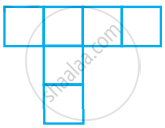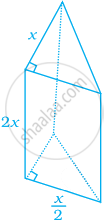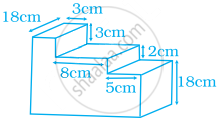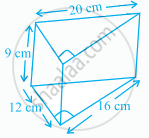Advertisements
Advertisements
प्रश्न
Work out the surface area of following shape (use π = 3.14).

उत्तर
In the given figure, there is a cube of side 5 cm and a cylinder of height 20 cm and radius is 2 cm.
So, total surface area = surface area of the cube + curved surface area of cylinder
= 6(5)2 + 2π(2) × 20 ...`[(∵ "Surface area of cube" = 6a^2),(∴ "Surface area of cylinder" = 2 pirh)]`
= 150 + 80π
Total surface area = 150 + 251.2 = 401.2 cm2
Notes
In this question assume that cylinder is at end open.
APPEARS IN
संबंधित प्रश्न
Identify the net which can be used to make cube (cut out copies of the net and try it):

Which of the following is a two Dimensional figure?
In a three-dimensional shape, diagonal is a line segment that joins two vertices that do not lie on the ______ face.
A pentagonal prism has ______ faces.
Find the perimeter of the given figure.

Find the area of the shaded portion in the following figure.

Find the volume of the given figure if volume = base area × height.

Find the volume of the given figure if volume = base area × height.

Work out the surface area of following shape (use π = 3.14).

Work out the surface area of following shape (use π = 3.14).

A solid with no vertex is ______.
Two dimensional figures are also called plane figures.
Draw a net of the solid given in the figure:

The circle, the square, the rectangle and the triangle are examples of plane figures.
The circle, the square, the rectangle and the triangle are examples of plane figures.
The circle, the square, the rectangle and the triangle are examples of plane figures.
The circle, the square, the rectangle, and the triangle are examples of plane figures.
The circle, the square, the rectangle and the triangle are examples of plane figures.
The circle, the square, the rectangle and the triangle are examples of plane figures.
